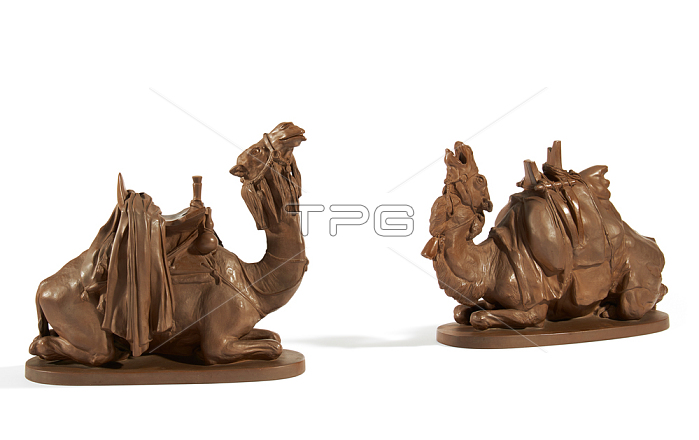
BOETTGER STONEWARE FIGURINES OF A DROMEDARY AND A BACTRIAN CAMEL.
Meissen. Model E. H鰏el; 1939.
B鰐tger stoneware; partly polished. Both animals are depicted lying down. The dromedary wears a halter with fringes and a saddle strapped to its back. Over this a long cloth is draped; which falls down at the side of the animal. A pumpkin bottle and an instrument hang from the knob.
The bactrian camel can be recognized by its long; dense fur. It carries a bridle with a
bell around its neck and a pack saddle. It has tilted its head backwards and opened its
mouth as if it were expelling a call.. Length 46 and 50cmcm.
Swords mark and 'B鰐tger Steinzeug' V192{V193; porcelain former no. 50{124; both with embossing stamp L230. Condition A resp. A/B.
Provenance:
Personal gift from E. H鰏el. By inheritance still in family ownership.
Literature:
- Marusch-Krohn; Caren: Meissen porcelain 1918-1933; Pfeiffer period; Leipzig 1993; for
B鰐tger stoneware pp.18-20; for Erich H鰏el p.154.
- Br鰄an; Karl H. (ed.:) Porzellan; Kunst und Design 1889-1939; from Art Nouveau to
Functionalism; catalogue Bd.V.2 of the Br鰄an-Museum; Berlin; 1996. For animal sculpture
in Meissen see p.65.
It was in March 1709; when Johann Friedrich B鰐tger; in a message to August the Strong;
was able to announce the invention of the "red porcellain" and the coveted "white
porcellain". The red porcelain stoneware; named 'B鰐tgersteinzeug' after its inventor; was
mainly used for the production of vessels; which could be sold as the first products of
the Meissner Porzellanmanufaktur founded in 1710. The elaborate production process as well
as the aesthetic preference of the 18th century for white porcelain; however; meant that
the red stoneware was quickly forgotten. As early as 1741 it was no longer mentioned in
the manufactory's recipe books.
It was not until the beginning of the 20th century that the first attempts were made in
Meissen to research the composition and manufacture of B鰐tger stoneware anew. The
reproduction of an almost identical body was finally successful in 1919; under the general
management of Max Adolf Pfeiffer. It is thanks to his commitment that the B鰐tger
stoneware at the Art Nouveau manufactory experienced a renaissance. Pfeiffer sought the
cooperation of well-known artists for new models; who; in addition to coins; medals and
plaques; also designed figures and above all animal sculptures in B鰐tger stoneware.
In addition to well-known modellers such as August Gaul and Max Esser; Erich H鰏el; who
had been working at the manufactory since 1903 as a design manager; was also involved with
the rediscovered material. It was thanks to H鰏el's influence as head of design that
Meissen became the leading German manufacturer of animal sculptures at the beginning of
the 19th century. The genre enjoyed an unprecedented popularity in Art Nouveau; after it
had been rediscovered and reinterpreted in Copenhagen. H鰏el recognised the potential of
the Danish designs and began to build its own Meissner menagerie.Art trade; Van Ham.
| px | px | dpi | = | cm | x | cm | = | MB |
Details
Creative#:
TOP28416475
Source:
達志影像
Authorization Type:
RM
Release Information:
須由TPG 完整授權
Model Release:
No
Property Release:
No
Right to Privacy:
No
Same folder images:

 Loading
Loading